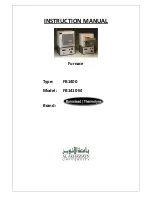
-- 57 --
;;
;;
BURNER FLAME
BURNER
MANIFOLD
A89020
Fig. 50 -- Burner Flame
R
Y W G
10 TURNS
THERMOSTAT SUBBASE
TERMINALS WITH
THERMOSTAT REMOVED
HOOK-AROUND
VOLT/AMMETER
EXAMPLE:
5.0 AMPS ON AMMETER
10 TURNS AROUND JAWS
= 0.5 AMPS FOR THERMOSTAT SETTING
FROM UNIT 24-VOLT
TERMINAL BLOCK
A80201
Fig. 51 -- Amp Draw Check with Ammeter
2. When thermometer readings stabilize, subtract return-air
temperature from supply-air temperature to determine air
temperature rise.
3. Adjust temperature rise by adjusting blower speed.
Increase blower speed to reduce temperature rise.
Decrease blower speed to increase temperature rise.
ELECTRICAL SHOCK HAZARD
Failure to follow this warning could result in personal injury
or death.
Disconnect 115--v electrical power before changing speed tap.
!
WARNING
4. To change blower motor speed selections for heating
mode, remove blower motor lead from control center
HEAT terminal. (See Fig. 34.) Select desired blower motor
speed lead from 1 of the other motor leads and relocate it
to HEAT terminal. See Table 18 for lead color
identification. Reconnect original lead on SPARE terminal.
Follow this same procedure for proper selection of COOL
speed selection.
Table 18 – Speed Selector
COLOR
SPEED
FACTORY
SHIPPED
CONNECTION
Black
High
Cool
Yellow (When Present)
Medium High
Spare
Blue
Medium Low
Heat
Red
Low
Spare
White
Common
Com
ADJUST BLOWER OFF DELAY (HEAT MODE)
The blower off delay has 4 adjustable settings from 90 sec to
180 sec. (See Table 19.) The blower off delay jumpers are located
on the furnace control board. (See Fig. 34.) To change the blower
off delay setting, move the jumper from one set of pins on the
control board to the pins used for the desired blower off delay.
Factory blower off delay setting is 120 sec.
Table 19 – Blower Off Delay Setup Position
PINS
1 AND 2
2 AND 3
3 AND 4
4 AND 5
Time (in sec)
90
120
150
180
SET THERMOSTAT HEAT ANTICIPATOR
When using a nonelectronic thermostat, the thermostat heat
anticipator must be set to match the amp draw of the electrical
components in R--W circuit. Accurate amp draw readings can be
obtained at thermostat subbase terminals R and W. Fig. 51
illustrates the easy method of obtaining actual amp draw. The
amp reading should be taken after blower motor has started and
furnace is heating. Connect ammeter wires as shown in Fig. 51.
The thermostat anticipator should NOT be in the circuit while
measuring current. If thermostat has no subbase, the thermostat
must be disconnected from R and W wires during current
measurement. See thermostat manufacturer’s instructions for
adjusting heat anticipator and for varying heating cycle length.
For an electronic thermostat, set cycle rate for 3 cycles per hour.
Step 6 -- Check Safety Controls
This section covers the safety controls that must be checked
before the installation is complete. The flame sensor, gas valve,
and pressure switch were all checked in the Start-up procedure
section as part of normal operation.
CHECK PRIMARY LIMIT CONTROL
This control shuts off gas control system and energizes
air-circulating blower motor if furnace overheats. Recommended
method of checking this limit control is to gradually block off
return air after furnace has been operating for a period of at least
5 minutes. As soon as limit control has shut off burners, return-air
opening should be unblocked to permit normal air circulation. By
using this method to check limit control, it can be established that
limit is functioning properly and operates if there is a restricted
return-air duct or motor failure. If limit control does not function
during this test, cause must be determined and corrected.
CHECK PRESSURE SWITCH
This control proves operation of draft inducer. Check switch
operation as follows:
1. Turn off 115-v power to furnace.
2. Remove main furnace door and disconnect inducer motor
lead wires from wire harness.
3. Turn on 115-v power to furnace.
4. Set thermostat to call for heat and wait 1 minute. When
pressure switch is functioning properly, hot surface igniter
should NOT glow, and control status code LED flashes a
Status Code 31. If hot surface igniter glows when inducer
58MCB




































